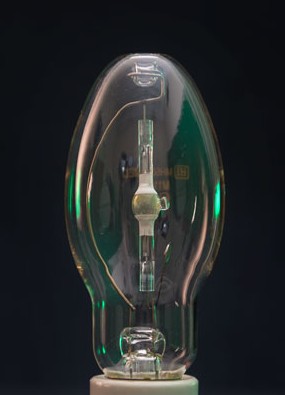by Brianna Crandall — January 29, 2016—The National Institute of Standards and Technology (NIST) has been issued a patent for a novel method to improve the performance and utility of the sort of high-intensity discharge (HID) lamps used for stadium and shopping-mall lighting, illumination for movie and TV productions that require excellent color rendition, and even indoor horticulture and automobile headlights.
Developed by John J. Curry of NIST’s Physical Measurement Laboratory (PML) in collaboration with two scientists then at OSRAM Sylvania, Walter Lapatovich and Edgar Estupinan, the new scheme is intended to rectify a long-standing difficulty with metal halide HID lamps: they can take many minutes to warm up while the halide solids in the lamp’s sealed glass chamber are vaporized by an electric arc and heated to levels at which they emit white light.

A representative HID lamp: the inner spherical chamber at the center holds the metal halides. Image: NIST/PML
During that warm-up interval, HID lamps emit weak and fluctuating amounts of light in undesirable colors. By contrast, some variations on NIST’s patented system can reportedly take as little as a few seconds to reach full white-light output.
The collaboration began in 2007, as the HID lighting industry was shifting from traditional metal halides such as sodium iodide and scandium iodide to compounds with lanthanide metals such as cerium, dysprosium, holmium, etc. To help meet the challenges of working with the various rare-earth iodides, one of the HID co-inventors suggested using Curry’s method of x-ray induced fluorescence in lamps.
The team also used a phenomenon called “complexing,” by mixing two different metal halides – the primary compound needed to generate the light, and a secondary halide that has a higher vapor pressure. This proved to be effective in shortening the warm-up time.
Curry says the “joint and open” public-private partnership “produced benefits for both the lighting industry and the American public,” with fundamental data that is “now openly available to the entire industry and other researchers.”
Gerald Fraser, Chief of PML’s Sensor Science Division, said of the work:
From Thomas Edison’s initial invention of the modern lightbulb, lighting continues to be an area of great innovation due to its importance in so many aspects of our daily lives. The present work is a clear example where a sophisticated understanding of the complex chemical and physical processes occurring within a light bulb offered the opportunity to make a significant enhancement in performance to the advantage of users who enjoy the excellent color rendering that HID lighting provides.




